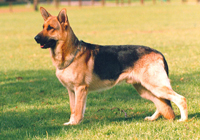As cited by the Kennel Club:
A Breed Standard is the guideline which describes the ideal characteristics, temperament and appearance of a breed and ensures that the breed is fit for function.
General Appearance
Slightly long in comparison to height; of powerful, well muscled build with weather-resistant coat. Relation between height, length, position and structure of fore and hindquarters (angulation) producing far-reaching, enduring gait. Clear definition of masculinity and femininity essential, and working ability never sacrificed for mere beauty.
Characteristics
Versatile working dog, balanced and free from exaggeration. Attentive, alert, resilient and tireless with keen scenting ability.
Temperament
Steady of nerve, loyal, self-assured, courageous and tractable. Never nervous, over-aggressive or shy.
Head and Skull
Proportionate in size to body, never coarse, too fine or long. Clean cut; fairly broad between ears. Forehead slightly domed; little or no trace of central furrow. Cheeks forming softly rounded curve, never protruding. Skull from ears to bridge of nose tapering gradually and evenly, blending without too pronounced stop into wedge-shaped powerful muzzle. Skull approximately 50 per cent of overall length of head. Width of skull corresponding approximately to length, in males slightly greater, in females slightly less. Muzzle strong, lips firm, clean and closing tightly. Top of muzzle straight, almost parallel to forehead.
Medium-sized, almond-shaped, never protruding. Dark brown preferred, lighter shade permissible, provided expression good and general harmony of head not destroyed. Expression lively, intelligent and self-assured.
Ears
Medium-sized, firm in texture, broad at base, set high, carried erect, almost parallel, never pulled inwards or tipped, tapering to a point, open at front. Never hanging.
Mouth
Jaws strongly developed. With a perfect, regular and complete scissor bite, i.e. upper teeth closely overlapping lower teeth and set square to the jaws. Teeth healthy and strong.
Neck
Fairly long, strong, with well developed muscles, free from throatiness. Carried at 45 degrees angle to horizontal, raised when excited, lowered at fast trot.
Forequarters
Shoulder blade and upper arms are equal in length, well muscled and firmly attached to the body. Shoulder blades set obliquely (approximately 45 degrees) laid flat to body. Upper arm strong, well muscled, joining shoulder blade at approximately 90 degrees. Seen from all sides, the forearms are straight and, seen from the front, absolutely parallel. Bone oval rather than round. The elbows must turn neither in nor out while standing or moving. Pasterns firm, supple, with a slight forward slope. An over long, weak pastern, would affect a dog’s working ability. Length of foreleg slightly exceeds the depth of chest.
Body
Length measured from point of shoulder to point of buttock, slightly exceeding height at withers. Correct ratio 10 to 9 or 8 and a half. Chest deep (45-48 per cent) of height at shoulder, not too broad, brisket long, well developed. Ribs well formed and long; neither barrel-shaped nor too flat; allowing free movement of elbows when gaiting. Relatively short loin. Belly firm, only slightly drawn up. Back between withers and croup, straight, strongly developed, not too long. Overall length achieved by correct angle of well laid shoulders, correct length of croup and hindquarters. The topline runs without any visible break from the set on of the neck, over the well defined withers, falling away slightly in a straight line to the gently sloping croup. The back is firm, strong and well muscled. Loin broad, strong, well muscled. Croup slightly sloping and without any break in the topline, merges imperceptibly with the set on of the tail.
Hindquarters
Overall strong, broad and well muscled, enabling effortless forward propulsion. Upper and lower thigh are approximately of equal length. Hind angulation sufficient if imaginary line dropped from point of buttocks cuts through lower thigh just in front of hock, continuing down slightly in front of hindfeet. Angulations corresponding approximately with front angulation, without over-angulation. Seen from rear, the hind legs are straight and parallel to each other. The hocks are strong and firm. The rear pasterns are vertical. Any tendency towards over-angulation of hindquarters, weak hocks, cow hocks or sickle hooks, reduces firmness and endurance in movement.
Feet
Rounded toes well closed and arched. Pads well cushioned and durable. Nails short, strong and dark in colour.
Tail
Bushy-haired, reaches at least to hock – ideal length reaching to middle of metatarsus. At rest tail hangs in slight sabre-like curve; when moving raised and curve increased, ideally never above level of back.
Gait/Movement
Sequence of step follows diagonal pattern, moving foreleg and opposite hindleg forward simultaneously; hindfoot thrust forward to midpoint of body and having equally long reach with forefeet without any noticeable change in backline.
Coat
Outer coat consisting of straight, hard, close-lying hair as dense as possible; thick undercoat. Hair on head, ears, front of legs, paws and toes short; on back, longer and thicker; in some males forming slight ruff. Hair longer on back of legs as far down as pasterns and stifles and forming fairly thick trousers on hindquarters.
Colour
Black or black saddle with tan, or gold to light grey markings. All black, all grey, with lighter or brown markings referred to as Sables. Bi-colour: Predominantly black, may have tan or gold markings on head, chest, legs and feet; black markings may be present on toes and rear pasterns. Nose black. Light markings on chest or very pale colour on inside of legs permissible, as are whitish nails, red-tipped tails or wishy-washy faded colours defined as lacking in pigmentation. Blues, livers, albinos, whites (i.e. almost pure white dogs with black noses) and near whites highly undesirable. Undercoat, except in all black dogs, usually grey or fawn. Colour in itself is of secondary importance having no effect on character or fitness for work. Final colour of a young dog only ascertained when outer coat has developed.
Size
Ideal height (from withers and just touching elbows): dogs: 63 cms (25 ins); bitches: 58 cms (23 ins). 2.5 cms (1 in) either above or below ideal permissible.
